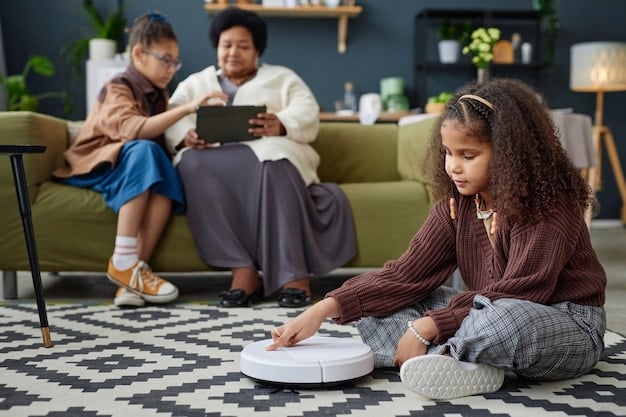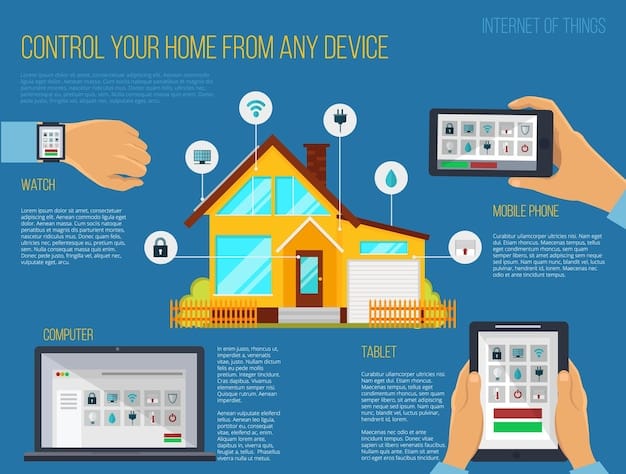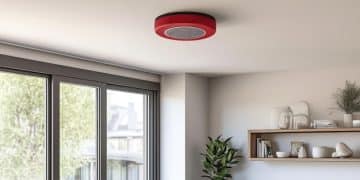Voice-Activated Home Security: Is It Right for Your US Family in 2025?

Anúncios
For US families in 2025, voice-activated home security systems offer cutting-edge convenience and enhanced protection, integrating seamlessly into smart homes, but require careful consideration of privacy, cost, and technical complexity to determine suitability.
As we step further into 2025, the concept of a truly smart home continues to evolve, with an increasing emphasis on integrated security solutions. Among the most talked-about advancements is voice-activated home security: Is It Right for Your US Family in 2025? This technology promises unparalleled convenience and control, allowing homeowners to arm or disarm systems, check camera feeds, or even lock doors using simple voice commands. However, deciding if this cutting-edge solution fits your household’s unique needs and lifestyle requires a closer look at its benefits, challenges, and overall implications.
The Rise of Voice Control in Home Security
The ubiquity of voice assistants like Amazon Alexa, Google Assistant, and Apple Siri has transformed how we interact with technology. This shift has naturally extended to home security, where the ability to control systems hands-free offers a new layer of convenience and responsiveness. In 2025, voice-activated security systems are no longer a futuristic dream but a tangible reality, integrating deeply into the fabric of smart home ecosystems.
These systems leverage natural language processing and artificial intelligence to interpret spoken commands, turning complex security management into an intuitive experience. Imagine leaving for work and simply saying, “Alexa, arm the house,” or checking on children from another room by asking, “Hey Google, show me the nursery camera.” This level of effortless interaction can significantly improve daily routines and peace of mind for busy families.
Enhanced Convenience and Accessibility
One of the primary drivers behind the adoption of voice-activated security is the sheer convenience it offers. Traditional keypads and mobile apps, while effective, require physical interaction. Voice commands, however, free up your hands and allow for quick actions even when busy. This can be particularly beneficial in situations where time is critical, such as disarming the alarm quickly upon returning home with arms full of groceries or activating a panic button during an emergency.
Furthermore, voice control enhances accessibility for individuals with mobility challenges or those who find small buttons and screens difficult to navigate. It allows a broader demographic to manage their home security effectively, fostering a more inclusive smart home environment. The ease of use also encourages more frequent interaction with the system, potentially leading to better overall security habits.
- Arm/disarm systems with spoken commands.
- Check camera feeds and recorded events.
- Lock/unlock smart doors remotely.
- Receive verbal alerts for detected activity.
The integration capabilities of these systems are also expanding. In 2025, it’s common for voice-activated security to connect with other smart home devices, creating automated routines. For instance, a “goodnight” command could not only arm the alarm but also dim the lights, adjust the thermostat, and lock all doors. This interconnectedness transforms simple commands into comprehensive home management actions, simplifying life for modern US families.
Key Features and Functionality in 2025
The sophistication of voice-activated home security systems has grown exponentially. Beyond basic arming and disarming, current models offer a suite of advanced features designed to provide comprehensive protection and seamless integration. Understanding these capabilities is crucial for US families considering an upgrade in 2025.
These systems often serve as the central hub for a larger smart home ecosystem. They can communicate with various connected devices, from smart locks and doorbell cameras to light bulbs and thermostats. This interoperability allows for the creation of intricate security routines triggered by voice commands or predefined schedules, enhancing both safety and convenience throughout the home.
Advanced Voice Recognition and AI
Modern voice-activated security systems often incorporate advanced voice recognition technology, capable of distinguishing between family members. This feature, known as voice biometrics, adds an extra layer of security, ensuring that only authorized individuals can control the system through voice commands. AI algorithms analyze vocal patterns and inflections, making it difficult for unauthorized voices to manipulate the system.
Some systems also include “liveness detection” to prevent recordings of authorized voices from being used. This sophisticated identification process significantly mitigates the risk of a breach via voice imitation. The continuous learning capabilities of these AI-powered systems mean they become more adept at understanding and responding to your specific voice patterns over time, improving accuracy and reliability.
Beyond simple commands, AI also supports proactive security measures. For example, some systems can interpret subtle environmental cues or integrate with motion sensors that differentiate between pets and intruders, reducing false alarms. This intelligent analysis, often processed locally rather than solely in the cloud, improves response times and overall system efficiency.

Seamless Integration with Smart Home Devices
The true power of voice-activated security systems lies in their ability to integrate seamlessly with a wide array of smart home devices. This creates a cohesive security network where all components work in concert to protect your home. For example, if a door sensor detects an intrusion when the system is armed, the voice assistant can trigger a series of actions:
-
Automatically lock all remaining smart doors.
-
Turn on interior and exterior lights to deter intruders.
-
Activate an audible alarm through smart speakers.
-
Initiate recording on connected security cameras.
This level of integration transforms a basic alarm system into a proactive, intelligent defense mechanism. Families can customize these responses based on their specific needs and preferences. Such interconnectedness simplifies daily operations, as arming your system can simultaneously adjust lighting and temperature settings, aligning with your routine as you leave or arrive home.
Furthermore, many systems support pre-programmed “scenes” that combine multiple actions. A “vacation mode” could, for instance, randomly turn lights on and off, simulate occupancy, and increase camera sensitivity, all activated with a single voice command. This comprehensive approach to home automation and security provides an unparalleled level of control and peace of mind for discerning families in the US.
Addressing Privacy and Security Concerns
While voice-activated home security offers undeniable benefits, it also introduces valid concerns regarding privacy and data security. For US families, understanding how these systems collect, process, and protect your personal information is paramount. In 2025, manufacturers are increasingly focused on building trust through robust security protocols and transparent data practices.
The primary concern revolves around the constant listening capability of voice assistants. Though designed to only activate upon a “wake word,” the perception that these devices are always recording can be unsettling. Manufacturers assert that audio is only processed after the wake word is detected, and this processing often occurs on the device itself to minimize data transmission to the cloud.
Data Encryption and Cloud Security
Reputable security providers employ stringent data encryption protocols to protect your voice commands and any associated data. This includes end-to-end encryption for audio streams and robust cybersecurity measures for cloud storage. Data centers used by these companies are typically highly secure, often compliant with industry-leading standards like ISO 27001.
However, no system is entirely impervious to cyber threats. It’s crucial for consumers to choose providers with a strong track record of security and to ensure their home network is also adequately protected. Using strong, unique passwords for Wi-Fi and smart home accounts, and enabling two-factor authentication, are essential steps in bolstering overall security.
Furthermore, many systems offer local processing options for certain commands, reducing the reliance on cloud servers for every interaction. This “edge computing” approach enhances both privacy and speed, as sensitive data remains within the home network whenever possible. Families should look for systems that prioritize on-device processing for routine commands.
- End-to-end encryption for voice data.
- Secure cloud storage and data centers.
- On-device processing for sensitive commands.
- Two-factor authentication for account access.
Voice Recognition and User Authentication
To prevent unauthorized access, many voice-activated systems incorporate advanced voice recognition for user authentication. This technology, capable of distinguishing between different voices, acts as a digital gatekeeper, ensuring that only registered family members can issue critical security commands. This feature prevents accidental or malicious activation by strangers or even recordings of your voice.
However, it’s important to understand the limitations. While sophisticated, voice biometrics are not infallible and can sometimes be tricked by very accurate voice synthesizers or close impersonations. Therefore, voice authentication should be seen as one layer of security, complementing physical controls and other verification methods. Regularly updating software and firmware provided by the manufacturer is also crucial for patching any discovered vulnerabilities.
Families should consider systems that allow for custom PINs or other secondary authentication methods for critical commands, such as disarming the alarm or unlocking doors. This multi-factor approach provides the most robust defense against potential breaches, ensuring that convenience does not come at the expense of security.
Installation and Setup for US Families
For US families considering voice-activated home security in 2025, the installation and setup process is a critical factor. Modern systems are designed to be user-friendly, with many offering DIY options, while others benefit from professional installation. The choice often depends on the complexity of the system and the homeowner’s technical comfort level.
Most voice-activated security systems integrate with existing smart home ecosystems or come as part of a comprehensive package. Setup typically involves connecting devices to your home Wi-Fi network and linking them to a central hub or cloud-based service before configuring voice commands. This streamlined process aims to make advanced security accessible to a broader audience.
DIY vs. Professional Installation
Many popular voice-activated security systems, particularly those from brands like Ring, Arlo, and SimpliSafe, are marketed as DIY-friendly. These kits often include detailed instructions, mobile apps with step-by-step guides, and pre-paired sensors. The benefits of DIY installation include cost savings and the flexibility to install components at your own pace.
However, professional installation offers certain advantages, especially for larger homes or complex setups. Technicians can ensure optimal placement of sensors and cameras, address Wi-Fi dead spots, and integrate the system seamlessly with existing smart home devices. They can also provide in-depth training on how to use all features, maximizing the system’s effectiveness. While more expensive upfront, professional installation can save time and prevent potential setup errors that could compromise security.
- DIY Installation: Cost-effective, flexible, requires basic technical aptitude.
- Professional Installation: Ensures optimal setup, expert integration, in-person training.
Regardless of the chosen method, attention to detail during setup is crucial. Misplaced sensors or improper Wi-Fi configuration can create vulnerabilities. Thoroughly testing all components, especially voice commands and alarm triggers, is essential before fully relying on the system for your family’s protection.
Many systems also offer ongoing technical support, whether through online resources, phone support, or even in-home visits. Leveraging these resources during the setup phase can help resolve any issues quickly and ensure the system functions optimally. The goal is to make the transition to voice-activated security as smooth as possible for every US family.
Cost Considerations and ROI
The investment in voice-activated home security systems for US families in 2025 varies significantly depending on the brand, features, and level of professional monitoring. While these systems offer advanced capabilities, understanding the total cost of ownership and potential return on investment (ROI) is crucial before making a decision.
Costs typically encompass the initial hardware purchase, potential installation fees, and ongoing monthly subscriptions for monitoring and cloud storage. The ROI isn’t just financial; it also includes peace of mind, insurance benefits, and increased property value. It’s important to look beyond the upfront price and consider the long-term value these systems provide.
Initial Hardware and Installation Costs
The initial outlay for voice-activated security hardware can range from a few hundred dollars for basic DIY kits to several thousand for comprehensive, professionally installed systems. Key components include the main hub (which often houses the voice assistant), cameras, motion sensors, door/window sensors, and smart locks. The more features and devices you integrate, the higher the upfront cost.
Installation costs can be a significant factor. DIY systems eliminate this expense, but professional installation, while adding to the initial price, ensures proper setup and can prevent costly errors. Some providers roll installation fees into the overall package or offer discounts to entice new customers. Financing options are also increasingly common, allowing families to spread the cost over time.
Families should budget not just for the devices themselves but also for any necessary accessories, such as additional smart plugs or range extenders to ensure full connectivity throughout the home. Thinking long-term about future expansions can also help in choosing a scalable system that won’t require a complete overhaul down the line.

Ongoing Subscriptions and Monitoring Services
Beyond the initial purchase, most voice-activated home security systems require ongoing subscriptions for services like professional monitoring, cloud video storage, and advanced smart features. Monthly fees can range from $10 to $50 or more, depending on the service level. Professional monitoring ensures that a dedicated team is alerted during an emergency, often contacting authorities on your behalf.
Cloud storage is essential for reviewing recorded video footage, especially from doorbell cameras and indoor/outdoor security cameras. The amount of storage and retention period often varies with the subscription tier. Some subscriptions also unlock advanced features such as AI-powered alerts (e.g., person detection vs. pet detection) and integration with third-party smart home devices.
- Basic plans: Cloud storage, app access, self-monitoring.
- Mid-tier plans: Professional monitoring, extended cloud storage, smart alerts.
- Premium plans: Advanced integrations, cellular backup, priority support.
While an added expense, these subscriptions contribute significantly to the system’s overall effectiveness and provide continuous protection. When calculating the ROI, consider potential discounts on home insurance premiums that many providers offer for homes with monitored security systems. This saving can partially offset the monthly subscription costs, making the investment more palatable for budget-conscious US families.
Compatibility and Ecosystem Choices
When selecting a voice-activated home security system for a US family in 2025, compatibility with existing smart home devices and the broader ecosystem is a paramount consideration. The market is populated by various platforms, each with its strengths, and choosing a system that integrates seamlessly with your current or future smart devices is crucial for a unified smart home experience.
Major players like Amazon Alexa, Google Assistant, and Apple HomeKit often serve as the foundational ecosystem. Many security systems are designed to work primarily within one of these, while others offer broader cross-platform compatibility. Understanding these relationships ensures that your new security system will truly enhance, rather than complicate, your daily life.
Choosing Your Core Voice Assistant
The choice of core voice assistant often dictates the primary ecosystem for your smart home. If you already own numerous Alexa-enabled devices, opting for an Alexa-compatible security system will provide the most fluid experience. The same applies to Google Assistant or HomeKit users. Each ecosystem has its unique set of compatible devices and services.
Consider which voice assistant your family uses most frequently and comfortably. This familiarity will lead to better adoption and utilization of the security features. While many modern systems offer some level of cross-compatibility, deep integration and advanced features often work best within their native ecosystem, providing a more cohesive and reliable experience.
Beyond the voice assistant, proprietary smart home hubs (like those from SmartThings or Hubitat) can act as central controllers, bridging different ecosystems and allowing for more complex automations. If you have a diverse range of smart devices from various manufacturers, such a hub might be essential for achieving true integration with your voice-activated security system.
- Amazon Alexa: Wide range of compatible devices, strong third-party support.
- Google Assistant: Excellent for Android users, integrates well with Google services.
- Apple HomeKit: High emphasis on privacy, seamless for Apple users.
Interoperability and Future-Proofing
As smart home technology rapidly evolves, selecting a system with strong interoperability standards is vital for future-proofing your investment. Look for systems that support open standards like Matter or Thread, which aim to create a more unified smart home experience, allowing devices from different manufacturers to communicate more easily.
Even without these new standards, many systems offer extensive integration with popular brands of smart locks, lighting, and thermostats. Before purchasing, verify that your desired security system explicitly supports the specific models of devices you already own or plan to acquire. This prevents incompatibility issues and ensures that all your smart devices can contribute to your overall home security strategy.
Researching the manufacturer’s commitment to future updates and device support is also important. A company that regularly releases firmware updates, new integrations, and improved features will ensure your voice-activated security system remains relevant and secure in the years to come. This proactive approach to development safeguards your investment and keeps your home at the forefront of smart security technology.
Potential Drawbacks & Limitations
While voice-activated home security offers undeniable benefits, it’s essential for US families to consider its potential drawbacks and limitations before fully committing. No technology is perfect, and understanding the challenges associated with these systems can help set realistic expectations and inform a more effective security strategy.
These limitations range from technical vulnerabilities and connectivity reliance to user-specific challenges like voice recognition accuracy in noisy environments. A balanced perspective allows for better decision-making and preparedness for any issues that may arise.
Reliance on Internet Connectivity and Power
A significant limitation of most voice-activated security systems is their heavy reliance on a stable internet connection and consistent power supply. Without Wi-Fi, voice commands may not be processed, and cloud-based features like remote monitoring, video streaming, and app control become inaccessible. While many systems offer cellular backup for monitoring, this often comes at an additional cost and primarily covers emergency alerts, not voice command functionality.
Power outages can also render many smart security devices inoperable. While some components like the main hub may have battery backup, cameras and sensors often require continuous power. Loss of power can leave your home vulnerable, highlighting the importance of considering alternative or traditional security measures as a backup, particularly in regions prone to power interruptions.
Users should also be aware of potential Wi-Fi interference or bandwidth limitations that could impact performance. A crowded Wi-Fi network or a weak signal in certain areas of the home can lead to delayed responses or dropped commands, frustrating users and potentially hindering timely security actions.
- System may not function without internet.
- Loss of power can disrupt device operation.
- Wi-Fi interference can cause connectivity issues.
- Cellular backup typically limited to monitoring.
Voice Recognition Accuracy and False Positives
Despite advancements, voice recognition technology is not infallible. Background noise, accents, illness, or even simply whispering can sometimes lead to misinterpretations or a failure to recognize commands. This can be particularly frustrating during an emergency when clear and immediate action is required. While systems are improving, 100% accuracy remains a challenge.
Furthermore, the risk of false positives or accidental activations exists. Young children playing, TV programs, or even a pet making a noise that sounds similar to a wake word or command could inadvertently trigger a security action. While modern systems often incorporate child locks or confirmation prompts, these issues can still occur and should be factored into a family’s considerations, especially if young children are present.
For critical security actions, relying solely on voice can be risky. Implementing a multi-factor authentication approach that combines voice with a PIN, facial recognition, or fingerprint scanning provides a more robust defense against unauthorized access and reduces the likelihood of unintentional triggers, ensuring that your home remains truly secure.
Making the Right Choice for Your Family
Deciding if voice-activated home security: Is It Right for Your US Family in 2025? requires a comprehensive evaluation of your specific needs, lifestyle, and priorities. This technology offers impressive convenience and advanced protection, but it’s not a one-size-fits-all solution. Careful consideration will ensure that your investment truly enhances your family’s safety and comfort.
The ideal system strikes a balance between cutting-edge features, reliable performance, manageable costs, and robust privacy safeguards. It should complement your family’s daily routines and integrate seamlessly with your existing or planned smart home ecosystem. Ultimately, the best choice is the one that provides genuine peace of mind without introducing unnecessary complexities or concerns.
Assessing Your Family’s Specific Needs
Begin by outlining your family’s unique security requirements. Do you have young children or elderly relatives who could benefit from hands-free control? Is convenience a top priority, or are you highly sensitive to privacy concerns? Evaluate your home’s layout, the number of entry points, and any specific areas needing surveillance. Consider your budget for both initial setup and ongoing subscriptions.
Think about your family’s technical comfort level. Are you eager to adopt new technologies, or do you prefer simpler, more traditional systems? While voice activation is designed to be intuitive, some level of technical engagement is still required for setup, troubleshooting, and customization. A system that aligns with your household’s digital literacy will be more effectively utilized.
Finally, assess your lifestyle. Frequent travelers might benefit more from remote monitoring and smart alerts, while those who work from home might prioritize internal camera access and smart lock integration. Tailoring the system to your family’s specific daily rhythm and security concerns will lead to greater satisfaction and efficacy.
Researching specific brands and models, reading reviews from other US families, and even trying out voice assistants in person can provide valuable insights. Many companies offer consultation services that can help you design a system tailored to your home and budget, making the decision process less daunting.
| Key Point | Brief Description |
|---|---|
| 🗣️ Unrivaled Convenience | Control security hands-free, enhancing daily routines and accessibility for all family members. |
| 🔒 Enhanced Security Layers | Features like voice biometrics and AI-driven alerts provide advanced protection. |
| 🌐 Smart Home Integration | Seamlessly connects with other smart devices for comprehensive automation. |
| ⚠️ Key Considerations | Privacy, internet reliance, and cost are important factors to evaluate before purchase. |
Frequently Asked Questions About Voice-Activated Home Security
While no system is 100% immune, reputable voice-activated security systems employ advanced encryption, secure cloud infrastructure, and often on-device processing. They also use features like voice biometrics and multi-factor authentication to enhance security. It’s crucial to choose trusted brands and secure your home network adequately.
Most voice-activated systems rely heavily on internet connectivity for full functionality. A loss of internet may prevent voice commands, remote app control, and cloud video storage. Many systems offer cellular backup for professional monitoring to ensure emergency alerts still go through, but core voice commands will be significantly impacted without Wi-Fi.
Yes, many advanced voice-activated security systems in 2025 incorporate voice biometrics and AI to distinguish between registered family members and unauthorized voices. This feature adds a layer of security, ensuring that sensitive commands, like disarming the alarm, respond only to recognized individuals, reducing the risk of misuse or false triggers.
Not always. Many popular voice-activated security systems offer user-friendly DIY installation options, complete with detailed instructions and app-guided setups. However, professional installation can ensure optimal placement, seamless integration with other smart devices, and in-depth training, which can be beneficial for complex setups or less tech-savvy users.
Beyond the initial hardware purchase, ongoing costs typically include monthly subscription fees for professional monitoring services, cloud video storage, and access to advanced smart features. These fees vary by provider and service tier, ranging from basic self-monitoring plans to comprehensive packages with cellular backup and AI-powered alerts.
Conclusion
In 2025, voice-activated home security systems represent a significant leap forward in residential protection, offering US families unparalleled convenience, advanced control, and seamless integration into smart home ecosystems. While the benefits of hands-free operation and intelligent automation are clear, a thoughtful assessment of privacy implications, system limitations, and associated costs is crucial. By carefully weighing these factors against your family’s unique needs and technical comfort, you can determine if this innovative technology is the right investment to enhance your home’s security and simplify your daily life.





